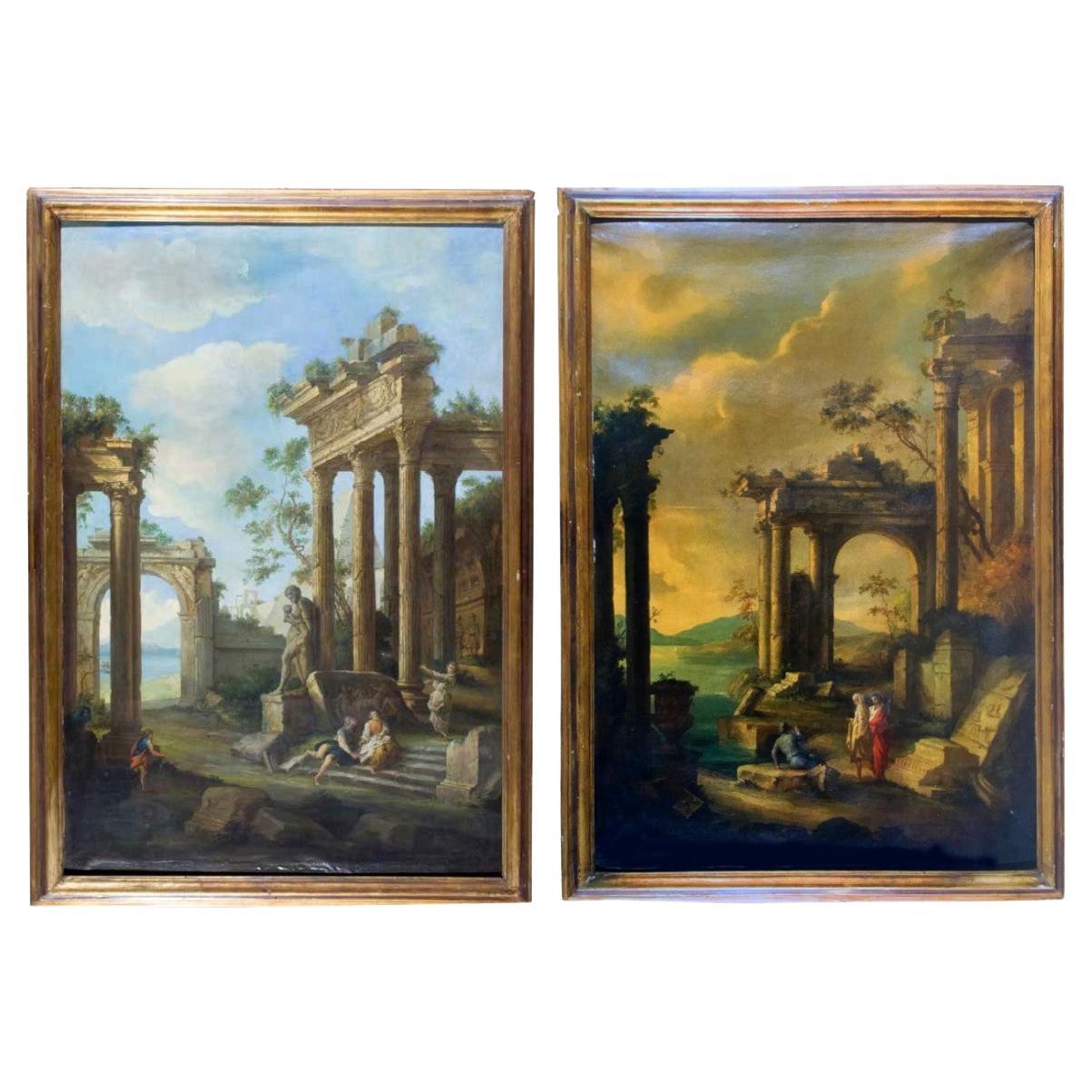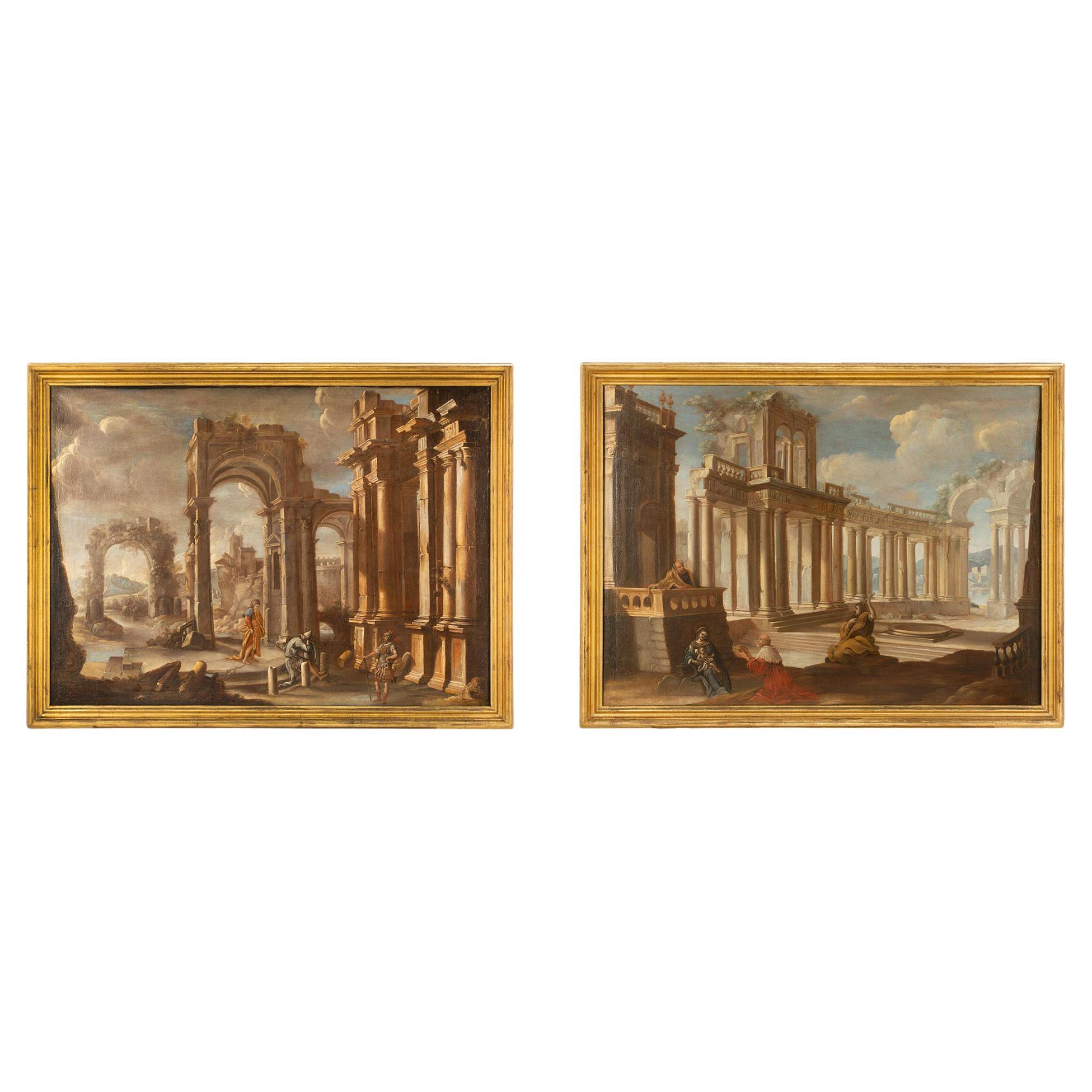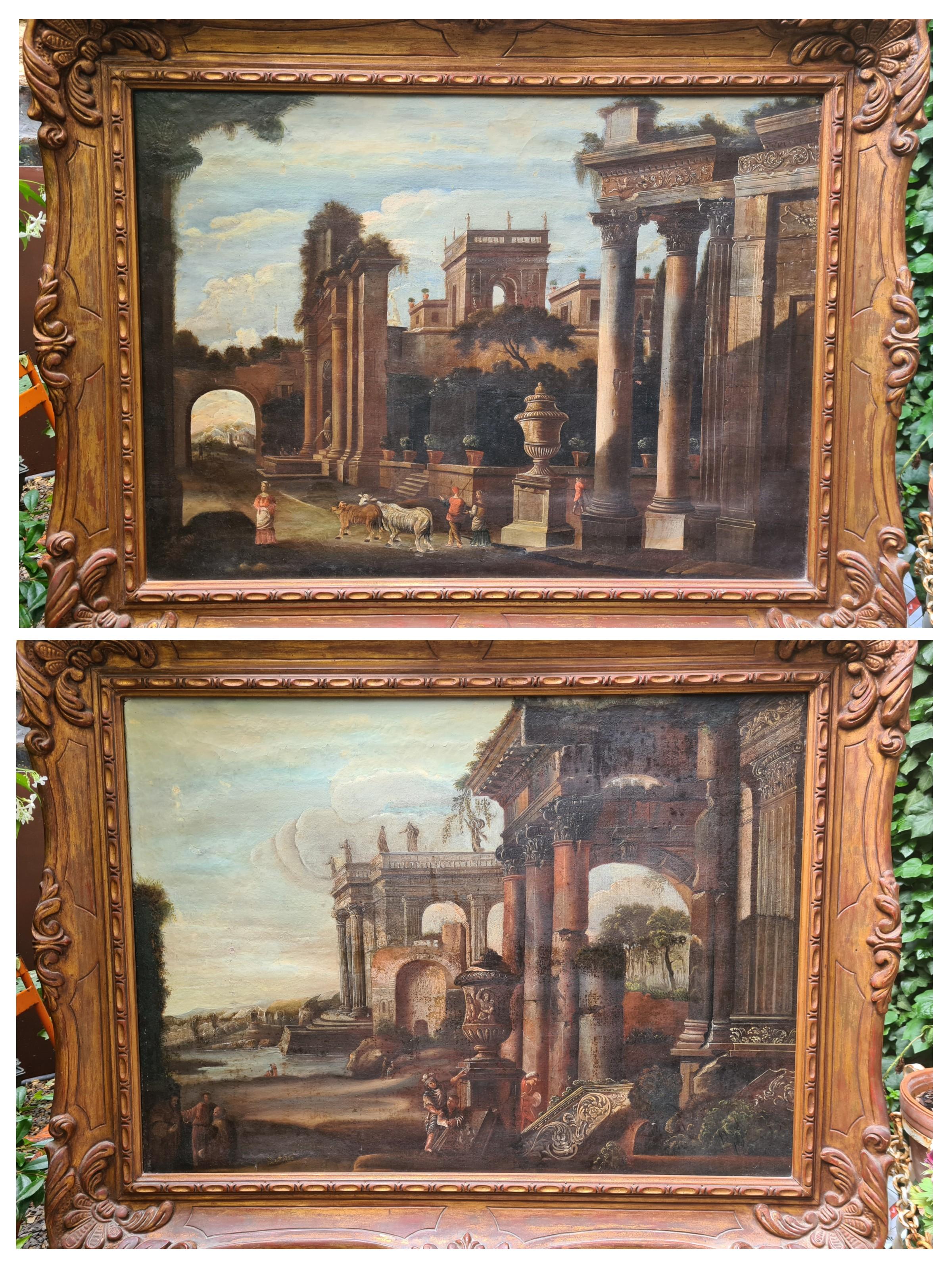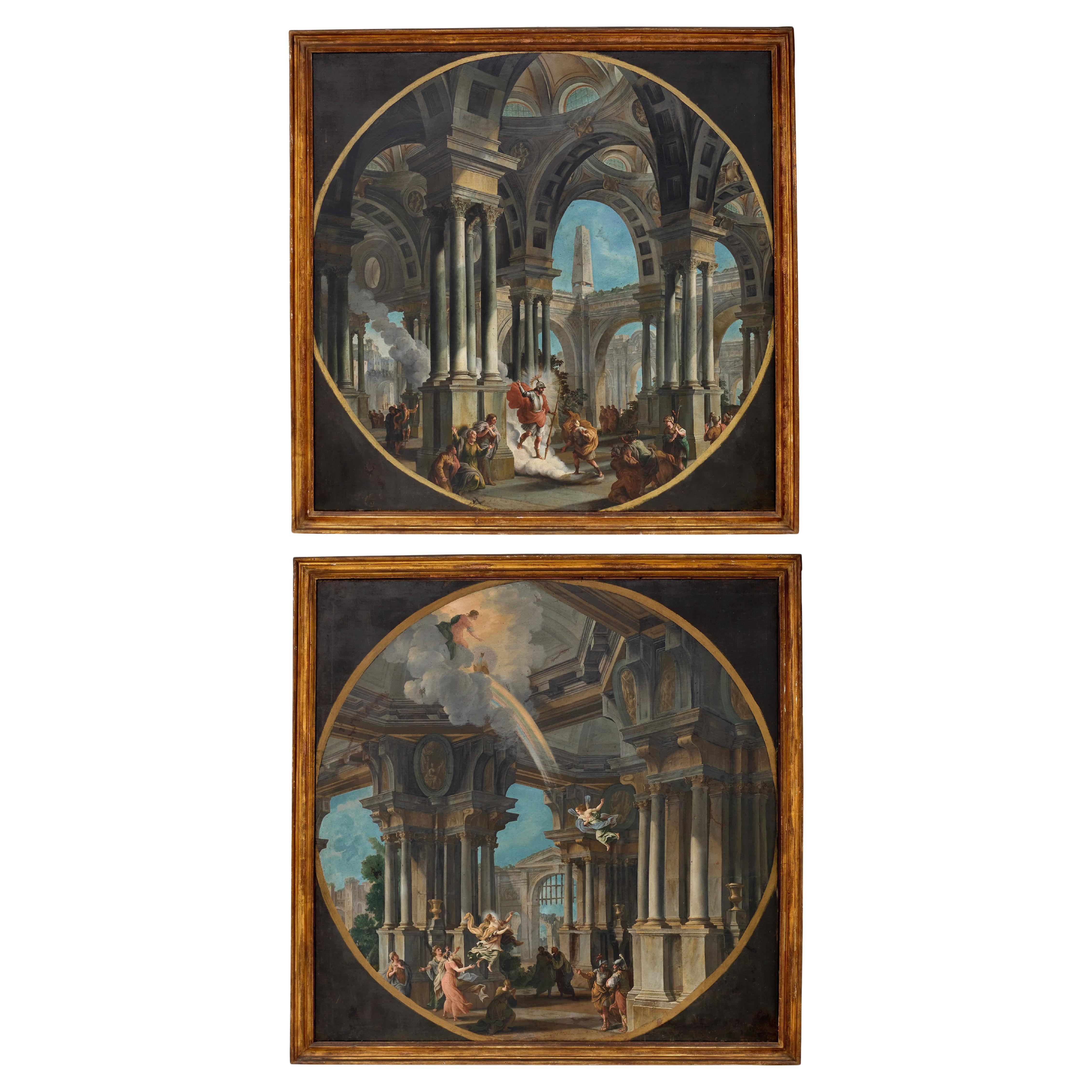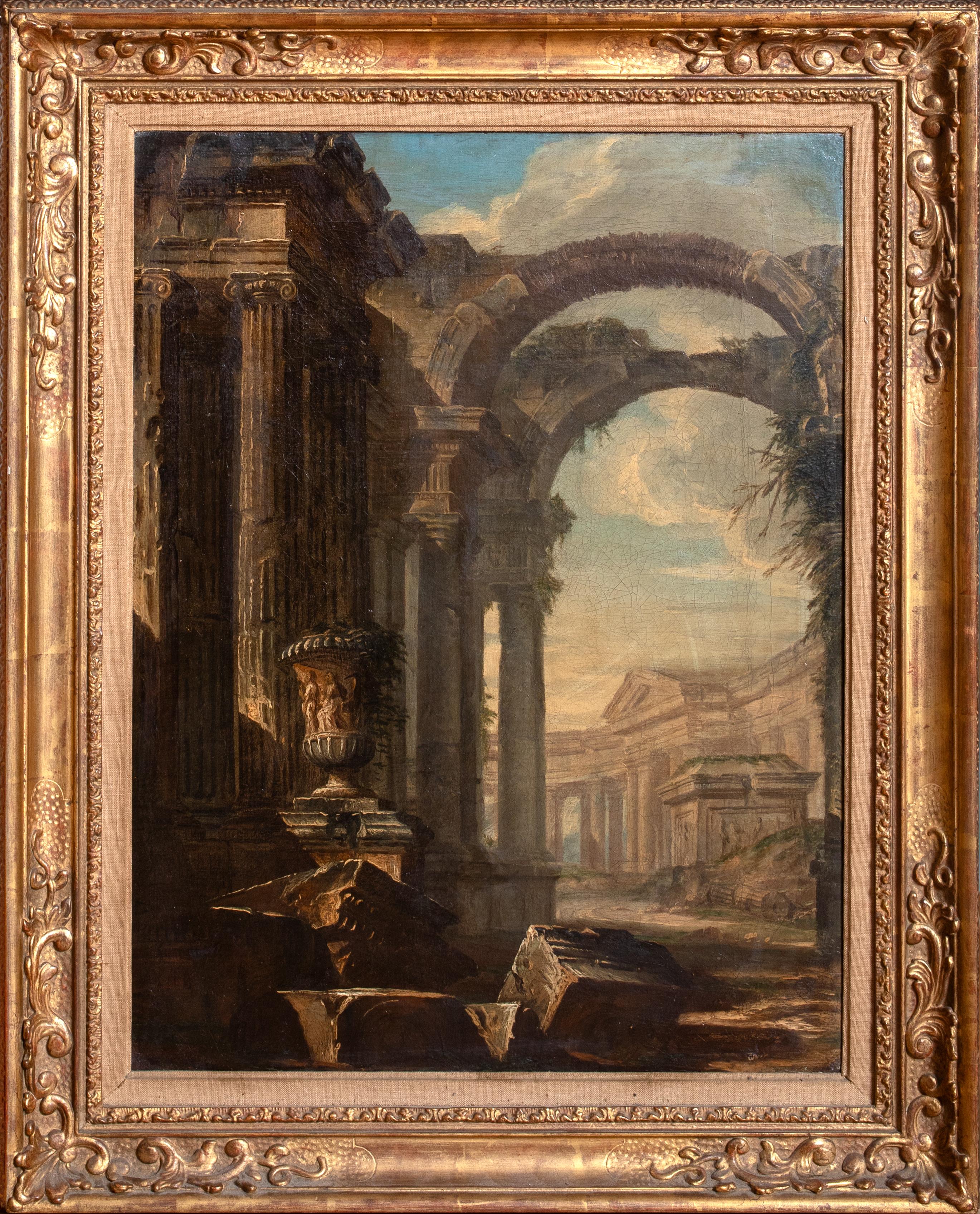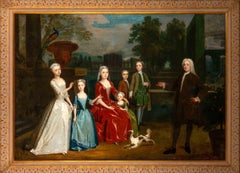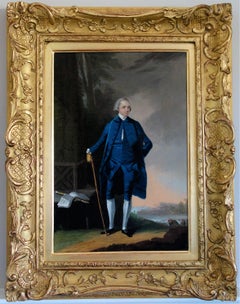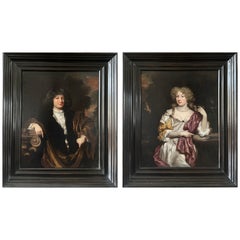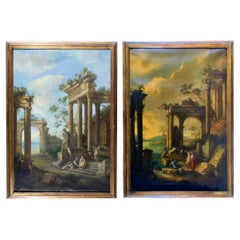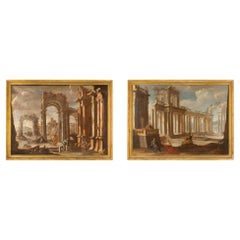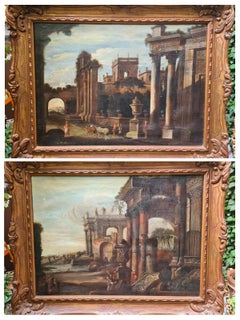Items Similar to A pair of 18th century Italian landscapes with classical ruins and figures
Want more images or videos?
Request additional images or videos from the seller
1 of 8
A pair of 18th century Italian landscapes with classical ruins and figurescirca 1750
circa 1750
$41,105
£30,000
€34,993.38
CA$56,303.57
A$62,621.86
CHF 32,699.19
MX$762,041.47
NOK 417,618.57
SEK 391,652.54
DKK 261,169.04
Shipping
Retrieving quote...The 1stDibs Promise:
Authenticity Guarantee,
Money-Back Guarantee,
24-Hour Cancellation
About the Item
A pair of 18th century Italian landscapes with classical ruins and figures, circa 1750.
Circle of Giovanni Panini (1691-1765)
Thomas Agnew and Sons, London, labels on the reverse
Each oil on canvas, 60 x 103cm (23 x 40in), in period giltwood frames
Provenance:
A F Marreco, Weidenfeld & Nicolson, 2 Cork Street, London
Sold by Thomas Agnew and Sons, Bond Street, London in 1957 as 'Panini'.
Giovanni Paolo, also known as Gian Paolo Panini or Pannini (17 June 1691 – 21 October 1765), was an Italian painter and architect who worked in Rome and is primarily known as one of the ‘vedutisti’ (view painters). As a painter, Panini is best known for his vistas of Rome, in which he took a particular interest in the city’s antiquities. Among his most famous works are his view of the interior of the Pantheon and his vedute—paintings of picture galleries containing views of Rome. Most of his works, especially those of ruins, have a fantasy element of embellishment, characteristic of capriccio themes where the artist draws on his imagination to group together decorative ruins, unlikely to be found in such close proximity in reality.
These paintings were very popular ‘Grand Tour’ souvenirs for wealthy tourists in the 18th century, allowing them to capture many of their favourite architectural sites combined into an impressive painting which they could take home and prominently display in their grand country homes.
.
- Creation Year:circa 1750
- Dimensions:Height: 23.63 in (60 cm)Width: 40.56 in (103 cm)
- Medium:
- Movement & Style:
- Circle Of:Giovanni Paolo Panini (1691 - 1765, Italian)
- Period:
- Condition:
- Gallery Location:Bath, GB
- Reference Number:1stDibs: LU95214004762
About the Seller
5.0
Vetted Professional Seller
Every seller passes strict standards for authenticity and reliability
Established in 2002
1stDibs seller since 2015
37 sales on 1stDibs
Associations
The British Antique Dealers' AssociationLAPADA - The Association of Arts & Antiques DealersInternational Confederation of Art and Antique Dealers' Associations
- ShippingRetrieving quote...Shipping from: Bath, United Kingdom
- Return Policy
Authenticity Guarantee
In the unlikely event there’s an issue with an item’s authenticity, contact us within 1 year for a full refund. DetailsMoney-Back Guarantee
If your item is not as described, is damaged in transit, or does not arrive, contact us within 7 days for a full refund. Details24-Hour Cancellation
You have a 24-hour grace period in which to reconsider your purchase, with no questions asked.Vetted Professional Sellers
Our world-class sellers must adhere to strict standards for service and quality, maintaining the integrity of our listings.Price-Match Guarantee
If you find that a seller listed the same item for a lower price elsewhere, we’ll match it.Trusted Global Delivery
Our best-in-class carrier network provides specialized shipping options worldwide, including custom delivery.More From This Seller
View All18th century portrait of sisters Lady Catherine and lady Jane Brydges
By James Maubert
Located in Bath, Somerset
This large double portrait depicts the sisters Lady Catherine and Lady Jane Brydges, the daughters of John Brydges, the Marquess of Carnarvon (1703-1727). They are seated on a stone...
Category
Early 18th Century Old Masters Portrait Paintings
Materials
Canvas, Oil
18th century painting of the Dalbiac family in the gardens of a country house
By Charles Philips
Located in Bath, Somerset
The painting depicts James (Jacques) Dalbiac, his wife Louise (ne de la Porte) and their five children, James, Charles, Louise, Marianne and Martha in the ornamental gardens of a grand country estate.
The extensive gardens extend into the distance with gardeners working in the background and figures strolling through the avenues of trees. A peacock and peahen can be seen on the wall to the left and a potted orange tree to the right. Louise Dalbiac holds an orange taken from the orange tree, aluding to the family's faith and their loyalty to the protestant King William of Orange and their adopted country.
The Dalbiacs were wealthy London silk and velvet merchants of French Huguenot origin who had fled France at the end of the 17th century to escape persecution for their protestant faith. England offered safe refuge and their skills and industriousness allowed them to establish one of the most successful businesses in London's Spitalfields which became a new centre of the silk trade, effectively leading to the collapse of the once dominant French silk industry. Both sons, James and Charles followed their father and Uncle into the family business, successfully growing the family's fortune and each going on to own their own country estates.
A conversation piece is a genre of painting used to describe group portraits of families and friends, often depicted with their servants and family pets and set within an elegantly furnished interior or the garden of a grand country house. They were a celebration of the intimacy of family relations as well as a sign of status, property and the power of succession. The informality of conversation pieces grew popular in 18th century England, allowing the sitters to present themselves in a more relaxed pose, perhaps engaged in intellectual conversation or showing their talents or interests. In this present portrait, the Dalbiacs are shown richly dressed and and at leisure in a grand country house setting, conveying their success and cultural and social aspirations.
Charles Philips (c.1703–1747) was an English artist known for painting a number of portraits and conversation pieces for noble and Royal patrons in the mid-eighteenth century. He was the son of portrait painter Richard Philips...
Category
Early 18th Century Old Masters Portrait Paintings
Materials
Canvas, Oil
18th century portrait of the German Flautist and composer Johann Joachim Quantz
By Arthur Devis
Located in Bath, Somerset
Portrait of Johann Quantz (1697-1773), flautist and composer, wearing a blue velvet coat, waistcoat and breeches, standing in a garden landscape with ...
Category
18th Century English School Portrait Paintings
Materials
Canvas, Oil
$14,797 Sale Price
20% Off
A pair of Dutch 17th century old master portraits of a husband and wife
By Nicolaes Maes
Located in Bath, Somerset
A rare pair of three-quarter length 'marriage' portraits by one of the foremost dutch portrait painters of the 17th century, Nicolaes Maes (Dordrecht 1634-1693 Amsterdam). The gentleman signed middle left 'Maes 1679'. Oil on canvas in dutch style ebonised frames. Dimensions 58 x 47.5cms each.
The gentleman is shown in a landscape at dusk, leaning against a stone capital, wearing a white chemise decorated with lace, a black coat and a brown silk cloak draped across his body.
The lady is elegantly dressed in an ivory silk gown decorated with jewels on the neckline and shoulders, the contrasting sleeves in gold fabric, with a rose pink silk cloak draped over her shoulder and bodice. She wears a pearl necklace and earrings with her fair hair worn up with ringlets falling down onto her chest in the fashionable style of the day. She stands with one hand touching a lock of her hair as she rests her arm on the bowl of a stone water drinking fountain...
Category
17th Century Old Masters Portrait Paintings
Materials
Canvas, Oil
18th century pastel portrait of a young boy in a wooded landscape
By Arthur Pond
Located in Bath, Somerset
This little jewel of a pastel of a young boy in his smart red jacket and silver trimmed waistcoat is by an artist working in the circle of Arthur Pond and ...
Category
18th Century English School Portrait Paintings
Materials
Pastel
$7,672 Sale Price
20% Off
19th century English School, Bay Horse and a Terrier in a Landscape
Located in Bath, Somerset
A bay hunter and a black and white short haired dog (possibly a bull terrier) in an extensive English landscape. a rustic barn in the near distance. Indistinctly signed 'Br...' and d...
Category
Early 19th Century English School Animal Paintings
Materials
Canvas, Oil
$9,317 Sale Price
20% Off
You May Also Like
Italian Painter of 1700 "Capriccio with classical ruins and figures"
Located in Cesena, FC
Painter of ruins xviii century:
"capriccio with classical ruins and four figures" , pendant with "capriccio with classical ruins and three figures"
Oil on canvas cm 140 x 95
The ...
Category
Antique 1730s Italian Paintings
Materials
Canvas
Pair of Italian Mid-18th Century Old Master Oil on Canvas Paintings of Ruins
Located in West Palm Beach, FL
A spectacular and extremely well executed pair of Italian mid 18th century Old Master oil on canvas paintings of ruins. Each painting displays wonderful perspectives, exceptional arc...
Category
Antique 18th Century Italian Paintings
Materials
Canvas, Giltwood
Huge 18th Century Classical Italianate Arcadian Landscape Figures & Buildings
Located in Cirencester, Gloucestershire
Figures in an Arcadian Landscape
Italian School, 18th century
follower of Claude Lorrain (French 1600-1682)
oil painting on canvas: 28 x 36 inches
framed: 39.5 by 47 inches
presented...
Category
18th Century Old Masters Landscape Paintings
Materials
Canvas, Oil
Pair of Grand Tour 18th Century Veduta Capriccio Paintings, After Gennaro Greco
Located in Cotignac, FR
A large pair of 18th century veduta capriccio scenes with temple ruins after Gennaro Greco from the circle of Pietro Cappelli. The paintings are presented in more modern carved gilt ...
Category
18th Century Baroque Landscape Paintings
Materials
Oil, Canvas
$17,253 Sale Price
20% Off
18th century, Couple of Italian Paintings Capriccio with Mythological Scenes
Located in IT
Couple of architectural capriccio with mythological scenes, oil on canvas, painter from Bologna active in the 18th century
The two large and valuable pantings depict two architectur...
Category
Antique Early 18th Century Italian Baroque Paintings
Materials
Canvas
Ancient Roman Architectural Ruins, 18th Century Giovanni Nicolas SERVANDONI
Located in Blackwater, GB
Ancient Architectural Ruins, 18th Century
circle of Giovanni Nicolas SERVANDONI (1695-1766)
Large 18th Century Italian Architectural Ruins, oil on canvas attributed to Giovanni Ser...
Category
18th Century Portrait Paintings
Materials
Canvas, Oil
$3,562 Sale Price
35% Off
More Ways To Browse
Classical Ruins
Pair Italian Figures
Italian Ruins Painting
Italy Ruins Painting
18th Century Italian Landscape Painting
18th Ruins Painting
Capriccio Painting
Oil Painting Capriccio
Capriccio Painting Italy
18th Century Capriccio
Giovanni Paolo Panini
William Winter
Dutch Painting Early 20th Century
Oil Paintings Of Poppies
Trip Park
Pink Sunset Paintings
Italian Marine Painting
John Wayne Painting
